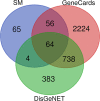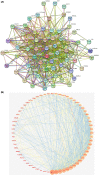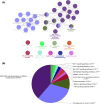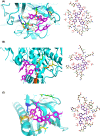Exploring the mechanisms underlying the therapeutic effect of Salvia miltiorrhiza in diabetic nephropathy using network pharmacology and molecular docking
- PMID: 33634308
- PMCID: PMC8209169
- DOI: 10.1042/BSR20203520
Exploring the mechanisms underlying the therapeutic effect of Salvia miltiorrhiza in diabetic nephropathy using network pharmacology and molecular docking
Abstract
The mechanisms underlying the therapeutic effect of Salvia miltiorrhiza (SM) on diabetic nephropathy (DN) were examined using a systematic network pharmacology approach and molecular docking. The Traditional Chinese Medicine Systems Pharmacology (TCMSP) database was used to screen active ingredients of SM. Targets were obtained using the SwissTargetPrediction and TCMSP databases. Proteins related to DN were retrieved from the GeneCards and DisGeNET databases. A protein-protein interaction (PPI) network was constructed using common SM/DN targets in the Search Tool for the Retrieval of Interacting Genes/Proteins (STRING) database. The Metascape platform was used for Gene Ontology (GO) function analysis, and the Cytoscape plug-in ClueGO was used for Kyoto Encyclopedia of Genes and Genomes (KEGG) pathway enrichment analysis. Molecular docking was performed using iGEMDOCK and AutoDock Vina software. Pymol and LigPlos were used for network mapping. Sixty-six active ingredients and 189 targets of SM were found. Sixty-four targets overlapped with DN-related proteins. The PPI network revealed that AKT serine/threonine kinase 1 (AKT1), VEGFA, interleukin 6 (IL6), TNF, mitogen-activated protein kinase 1 (MAPK1), tumor protein p53 (TP53), epidermal growth factor receptor (EGFR), signal transducer and activator of transcription 3 (STAT3), mitogen-activated protein kinase 14 (MAPK14), and JUN were the ten most relevant targets. GO and KEGG analyses revealed that the common targets of DN and SM were mainly involved in advanced glycation end-products, oxidative stress, inflammatory response, and immune regulation. Molecular docking revealed that potential DN-related targets, including tumor necrosis factor (TNF), NOS2, and AKT1, more stably bound with salvianolic acid B than with tanshinone IIA. In conclusion, the present study revealed the active components and potential molecular therapeutic mechanisms of SM in DN and provides a reference for the wide application of SM in clinically managing DN.
Keywords: Salvia miltiorrhiza; diabetic nephropathy; molecular docking; molecular mechanism; network pharmacology.
© 2021 The Author(s).
Conflict of interest statement
The authors declare that there are no competing interests associated with the manuscript.
Figures








Similar articles
-
Network pharmacology analysis combined with experimental validation to explore the therapeutic mechanism of Schisandra Chinensis Mixture on diabetic nephropathy.J Ethnopharmacol. 2023 Feb 10;302(Pt A):115768. doi: 10.1016/j.jep.2022.115768. Epub 2022 Oct 22. J Ethnopharmacol. 2023. PMID: 36280016
-
Identification of the molecular mechanisms of Salvia miltiorrhiza relevant to the treatment of osteoarthritis based on network pharmacology.Discov Med. 2020 Sep-Oct;30(160):83-95. Discov Med. 2020. PMID: 33382964
-
Exploring the pharmacological components and effective mechanism of Mori Folium against periodontitis using network pharmacology and molecular docking.Arch Oral Biol. 2022 Jul;139:105391. doi: 10.1016/j.archoralbio.2022.105391. Epub 2022 Mar 21. Arch Oral Biol. 2022. PMID: 35430443
-
Network pharmacology-based identification of miRNA expression of Astragalus membranaceus in the treatment of diabetic nephropathy.Medicine (Baltimore). 2022 Feb 4;101(5):e28747. doi: 10.1097/MD.0000000000028747. Medicine (Baltimore). 2022. PMID: 35119030 Free PMC article.
-
Exploring the mechanism of action of Yiyi Fuzi Baijiang powder in colorectal cancer based on network pharmacology and molecular docking studies.Biotechnol Genet Eng Rev. 2023 Oct;39(2):1107-1127. doi: 10.1080/02648725.2023.2167765. Epub 2023 Feb 3. Biotechnol Genet Eng Rev. 2023. PMID: 36735641 Review.
Cited by
-
Targeting colorectal cancer with Herba Patriniae and Coix seed: Network pharmacology, molecular docking, and in vitro validation.World J Gastrointest Oncol. 2024 Aug 15;16(8):3539-3558. doi: 10.4251/wjgo.v16.i8.3539. World J Gastrointest Oncol. 2024. PMID: 39171161 Free PMC article.
-
Role of Network Pharmacology in Prediction of Mechanism of Neuroprotective Compounds.Methods Mol Biol. 2024;2761:159-179. doi: 10.1007/978-1-0716-3662-6_13. Methods Mol Biol. 2024. PMID: 38427237
-
Data Mining and Network Pharmacology Analysis of Kidney-Tonifying Herbs on the Treatment of Renal Osteodystrophy Based on the Theory of "Kidney Governing Bones" in Traditional Chinese Medicine.Evid Based Complement Alternat Med. 2022 Sep 30;2022:1116923. doi: 10.1155/2022/1116923. eCollection 2022. Evid Based Complement Alternat Med. 2022. PMID: 36238608 Free PMC article.
-
Network Pharmacology Analysis and Experimental Verification Strategies Reveal the Action Mechanism of Danshen Decoction in Treating Ischemic Cardiomyopathy.Evid Based Complement Alternat Med. 2022 May 2;2022:7578055. doi: 10.1155/2022/7578055. eCollection 2022. Evid Based Complement Alternat Med. 2022. PMID: 35722148 Free PMC article.
-
Exploring the mechanism of fibrates regulating HIF-1A in the treatment of ischemic stroke based on network pharmacology and molecular docking.BMC Res Notes. 2024 Dec 26;17(1):387. doi: 10.1186/s13104-024-07031-z. BMC Res Notes. 2024. PMID: 39726005 Free PMC article.
References
Publication types
MeSH terms
Substances
LinkOut - more resources
Full Text Sources
Other Literature Sources
Medical
Research Materials
Miscellaneous

